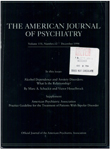Gender differences in pharmacokinetics and pharmacodynamics of psychotropic medication
Abstract
OBJECTIVE: This review explores the theoretical background for and empirical evidence supporting gender-related differences in pharmacokinetics and pharmacodynamic properties of psychotropic medications. METHOD: The authors reviewed all English-language articles on this topic that involved original research using human subjects. RESULTS: Limited evidence suggests that young women seem to respond better to and require lower doses of antipsychotic agents and benzodiazepines than young men. The administration of exogenous hormones interacts with medications, changing plasma levels and possibly conferring greater risks for toxicity. Young women may have an enhanced response to nontricyclic antidepressants. CONCLUSIONS: Too little basic and clinical research has been conducted on sex differences in therapeutic effects and side effects of psychopharmacological treatments. Addressing these differences as well as similarities will lead to safer and more effective treatment for all patients.
Access content
To read the fulltext, please use one of the options below to sign in or purchase access.- Personal login
- Institutional Login
- Sign in via OpenAthens
- Register for access
-
Please login/register if you wish to pair your device and check access availability.
Not a subscriber?
PsychiatryOnline subscription options offer access to the DSM-5 library, books, journals, CME, and patient resources. This all-in-one virtual library provides psychiatrists and mental health professionals with key resources for diagnosis, treatment, research, and professional development.
Need more help? PsychiatryOnline Customer Service may be reached by emailing [email protected] or by calling 800-368-5777 (in the U.S.) or 703-907-7322 (outside the U.S.).



